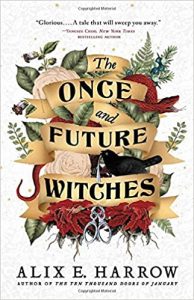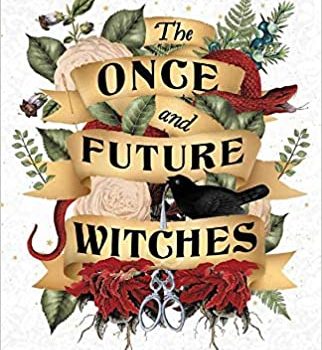Gary K. Wolfe Reviews The Once and Future Witches by Alix E. Harrow
 The Once and Future Witches, Alix E. Harrow (Redhook 978-0-316-42204-8, $28.00, 528pp, hc) October 2020.
The Once and Future Witches, Alix E. Harrow (Redhook 978-0-316-42204-8, $28.00, 528pp, hc) October 2020.
Despite its vampires, assassins, and a viciously conspiratorial patriarchy, the main sensibility I took away from Alix E. Harrow’s spectacular debut, The Ten Thousand Doors of January, was one of celebration – a celebration of portal fantasies, of secret histories, of favorite books and tales, most of all of the protagonists’ capacity to find and claim their own stories. Much the same might be said of her new novel The Once and Future Witches. To be sure, the plot, the late 19th-century setting, and the characters are entirely different, but her sometimes playful fascination with history, her not entirely original conviction that outsider groups can gain power from unity, and her celebration of women’s magic will seem familiar. For all this, the novel seems entirely new, including Harrow’s manner of telling the tale, as inventive in its own way as was Ten Thousand Doors. Sometimes she uses folksong-like repetition or anaphora to introduce characters in an intentionally formulaic way; she interpolates cleverly gender-reimagined versions of classic fairy tales and nursery rhymes; she sets the whole thing in a kind of gender-flipped alternate history (the classic fairy tale collectors were the Sisters Grimm, Charlotte Perrault, and Andrea Lang; Homer was translated by Alexandra Pope; a popular detective writer is Miss Doyle). An African-American character tells a story that converts Anansi to Aunt Nancy. Even historical events are subtly shifted, as when the notorious Triangle Shirtwaist fire becomes the “Square Shirtwaist fire,” Sometimes the narration takes on such an anthem-like voiceover tone that you can almost hear the music swelling:
The rest of the Sisters of Avalon are just maids or mill-workers, dancers or fortune-tellers, mothers or daughters. Everyday sorts of women with everyday sorts of problems, not worth mentioning in any story worth telling.
But tonight, beneath the Rose Moon of June, they are witches. They are crones and maidens, villains and temptresses, and all the stories belong to them.
Tone is crucial in any stories about stories, and pretty soon we’re enjoying this sort of thing as much as Harrow seems to enjoy writing it.
In Harrow’s version of history, the Salem witch trials involved real witches, eventually leading to the destruction of the town – hence the setting of New Salem (which probably has little to do with real villages with that name). The central characters are the three Eastwood sisters who have, separately, escaped an abusive father and who meet up again years later in New Salem, just as the women’s suffrage movement is taking hold in 1893. Harrow initially introduces them with a classic fairy-tale formula, focusing on their appearance: James Juniper is “the youngest, with hair as ragged and black as crow feathers”; Agnes is “the middle sister, with hair as shining and black as a hawk’s eye”; Beatrice is “the oldest sister, with hair like owl feathers: soft and dark, and streaked with early gray.” But, like a good teller of oral tradition, Harrow introduces them again from time to time, varying the formula to reflect the women’s growing self-determination and agency. Later in the novel, in a flurry of alliteration, we’re told that James is “the wild sister, fearless as a fox and curious as a crow”; Agnes is “the strong sister, steady as a stone and twice as hard”; Beatrice is “the wise sister, quiet and clever as an owl in the rafters.” How the sisters transform from archetypes into characters makes up a good part of what the first half of the novel is about.
As the story opens, middle sister Agnes is working in a textile-mill sweatshop, the older sister Beatrice is a college librarian, and James Juniper has just arrived in New Salem, penniless and homeless and wanted for the murder of her nightmare of a father. She is furious with her older sisters for having abandoned her to his abuse years earlier, and she has no intention of rejoining them until they accidentally meet when the “splitting open of the world” briefly reveals a massive black tower in the town square. The tower eventually becomes the focus of an increasingly apocalyptic confrontation. On one side are the sisters, who form a loose organization of witchy immigrants and factory workers called the Sisters of Avalon (including a delightful Russian woman who offers a revisionist Baba Yaga tale), and who find allies in the Daughters of Tituba, led by the African-American journalist Cleopatra Polaris Quinn, editor of the New Salem Defender. But the local suffragist group, the New Salem Women’s Association, is leery of having their political goals derailed by association with witches. They aren’t the real problem, though; that would be an ambitious, hate-mongering local politician named Gideon Hill, who has some ancient supernatural resources of his own, as well as a secret identity we learn of late in the novel. (Witchery, it seems, was never confined to women – they just got blamed for it.) As the stakes grow more dire, the novel takes on a more densely textured, almost epic dimension, raising the question of what sacrifices the sisters may need to make in order for their story – and the world – to survive. Even though the more mundane question of women’s suffrage may be a bit overshadowed by time we reach the spectacular conclusion, The Once and Future Witches, with its adroit balance of narrative playfulness and imminent tragedy, is as fully original and impressive as its predecessor, and is just a hoot to read.
Gary K. Wolfe is Emeritus Professor of Humanities at Roosevelt University and a reviewer for Locus magazine since 1991. His reviews have been collected in Soundings (BSFA Award 2006; Hugo nominee), Bearings (Hugo nominee 2011), and Sightings (2011), and his Evaporating Genres: Essays on Fantastic Literature (Wesleyan) received the Locus Award in 2012. Earlier books include The Known and the Unknown: The Iconography of Science Fiction (Eaton Award, 1981), Harlan Ellison: The Edge of Forever (with Ellen Weil, 2002), and David Lindsay (1982). For the Library of America, he edited American Science Fiction: Nine Classic Novels of the 1950s in 2012, with a similar set for the 1960s forthcoming. He has received the Pilgrim Award from the Science Fiction Research Association, the Distinguished Scholarship Award from the International Association for the Fantastic in the Arts, and a Special World Fantasy Award for criticism. His 24-lecture series How Great Science Fiction Works appeared from The Great Courses in 2016. He has received six Hugo nominations, two for his reviews collections and four for The Coode Street Podcast, which he has co-hosted with Jonathan Strahan for more than 300 episodes. He lives in Chicago.
This review and more like it in the October 2020 issue of Locus.
 While you are here, please take a moment to support Locus with a one-time or recurring donation. We rely on reader donations to keep the magazine and site going, and would like to keep the site paywall free, but WE NEED YOUR FINANCIAL SUPPORT to continue quality coverage of the science fiction and fantasy field.
While you are here, please take a moment to support Locus with a one-time or recurring donation. We rely on reader donations to keep the magazine and site going, and would like to keep the site paywall free, but WE NEED YOUR FINANCIAL SUPPORT to continue quality coverage of the science fiction and fantasy field.
©Locus Magazine. Copyrighted material may not be republished without permission of LSFF.







